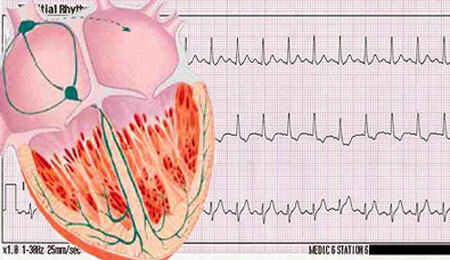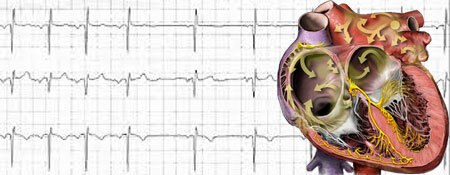The feet are always able to withstand a tremendous load. When thousands of years ago a man got up from four limbs to two, he freed his hands for productive labor, ensuring his kind of evolutionary progress. But the load on the feet at the same time increased many times.
With normal quiet walking, each foot rhythmically takes with every step the pressure, one and a half times more than our weight. During running, the pressure at the push to the ground is 4 times the weight of a person. When carrying heavy loads in hands, we complain that "hands fall off," and yet the venous leg system undergoes a test of strength.
Half of the able-bodied population of our country can boast of excessive weight, this also affects the condition of the veins. And there is walking on the stairs. And a part of the work has been adapted by the person to do squatting, while the outflow of blood is hampered, the veins expand and deform.
One can recall the egregious case with the rank-and-file Andrei S., whose co-workers-grandfathers were forced to squat for hours - this made him legless as a result of acute deep vein thrombosis.
Contents
- 1 What is simple
- 1.1 Types of blood clots
- 2 Causes of thrombosis of lower extremity veins
- 3 Symptoms of deep vein thrombosis of lower extremities
- 4 Complications of leg vein thrombosis
- 5 Diagnosis
- 6 Treatment of deep veins thrombosis of lower extremities
- 7 Prevention of deep vein thrombosis of legs
- 8 Deep vein thrombosislower limbs in the ICD 10
What is this in simple terms
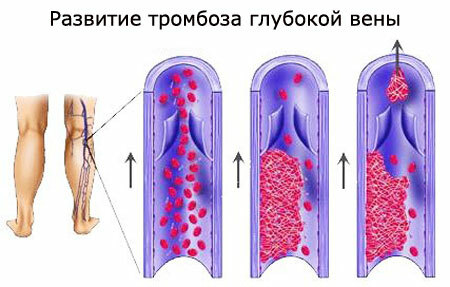
Thrombosis is a violation of the patency of the vessels due to the formation of intravital clots of crOvi in their lumen.
Arterial and venous vessels have different structures. On the arteries, as on mountain rivers, blood is quickly spread through the body as a result of cardiac contractions. The venous blood flows slowly like water in the flat rivers, except that, with the exception of the venous system of the head, the blood must also rise upward. And this requires a large tension of the venous walls and the presence of valves in the vessels, which counteract the movement of blood down.
In the middle of the 19th century. German pathologist R.Virchov formulated the conditions for thrombus:
- Violation of the inner layer of the walls of the vessels.
- Reduction in blood flow
- Increase in blood viscosity
The mechanism of formation of a dangerous thrombus is a protective natural reaction of the body. When the vessel is damaged, special blood cells - platelets, gluing together, clog the hole in the vascular wall. In this process, the plasma protein fibrinogen and other blood cells participate.
In inflammatory diseases of vessels, atherosclerosis, hypertension, intoxications and many painful conditions, the inner wall of the veins becomes rough. Platelets accumulate in this area, and a protective mechanism is activated.
If blood has increased viscosity( diabetes, animal fat intake, liver disease, infectious diseases) - the risk of clot formation increases. And in the presence of varicose veins and the weakening of the function of venous valves, the blood flow velocity, especially in the parietal zone, slows down.
This is how the "Virchow Trias" triad takes shape, without treatment often leading to a sad outcome.
Types of blood clots
In the structure of the blood clot, the head is identified, which it is attached to the vascular wall, the body and tail, freely fluttering in the bloodstream( "flotation").
Classify them according to their structure, mechanism of formation and in relation to the lumen of the vessel:
- pristenochny,
- obturating( fully covering the lumen of the vessel).
The causes of thrombosis of the lower extremities veins
The list of reasons shows how great the possibility of this pathology is:
- Age-related vascular sclerosis( densification of the vascular wall and narrowing of the lumen of arteries and veins after 40 years).
- Varicose disease.
- Heart Disease
- Excess weight increases the risk of thrombosis 5 times.
- Pregnancy.
- Operative intervention, especially under general anesthesia, and the risk of thrombosis increases proportionally to the duration of the operation.
- Leg fractures and gypsum immobilization of the limbs often provoke the development of thrombosis.
- Catheterization of veins.
- Damage to blood vessels as a result of injuries in the home and at work.
- Increased blood coagulability as a hereditary factor or acquired as a result of various pathological conditions.
- General supercooling and dehydration of the body.
- Bacterial and viral infectious diseases.
- Neoplasms of the lungs, ovaries, gastrointestinal tract, brain.
- Sluggish way of life, causing blood circulation disorders.
- Prolonged bed rest.
- Standing or sedentary work.
- Regular oral contraceptive use.
- Alcoholism.
- Smoking.
Symptoms of deep vein thrombosis of the lower extremities
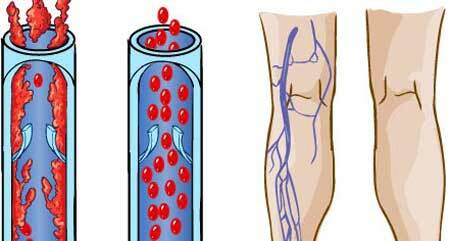
Deep vein thrombosis of the legs usually manifests itself as acute local inflammation:
- in the calf muscles there is an acute agonizing bursting pain radiating to the lower abdomen and to the sacral and lumbar spine;
- any movement increases pain;
- the drumstick and foot swell, giving a noticeable increase in volume;
- the skin of the limb acquires a cyanotic shade.
Simultaneously, general signs of the inflammatory process appear:
- general malaise,
- restriction of motor activity.
- increase in temperature,
- in the blood - the level of leukocytes and ESR increases.
Sometimes an acute thrombosis proceeds almost asymptomatically, which is even more dangerous - it is wasted precious time( the count goes for hours) to help before complications develop.
Complications of vein thrombosis
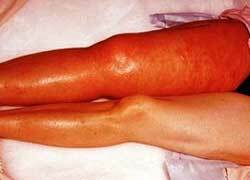
Complications of thrombosis
Without treatment, the acute process becomes chronic phlebotrombosis of deep and superficial veins. On the skin along the vessels can form ulcers and trophic ulcers.
Common acute phlebothrombosis causes trophism of tissues in the affected area, resulting in necrosis of cells and gangrene.
The thrombus slows the blood flow, the pressure in the affected vessel increases, which at some point causes the clot to separate.
A movable thrombus is called an embolus, when a pulmonary artery settles( 50% of untreated cases) or the heart of an embolus can cause death, a myocardial infarction, with a brain subsidence - a stroke.
Diagnosis
In addition to the characteristic signs of venous thrombosis, there are also specific symptoms:
- Moses - when squeezing the shin, there is a sharp soreness;
- of Lovenberg - squeezing of the tonometer of the calf with a cuff at values from 80 mm Hg. Art.strengthens the pain in the muscles of the lower leg;
- Louvel - sneezing and coughing give off with a sharp pain in the aching limb;
- Homansa - pain intensifies when flexing the foot.
Ultrasound duplex scanning helps distinguish thrombosis from other diseases of the venous and lymphatic systems, determines the location and extent of the lesion.
Phlebography - identifies mobile thrombi.
Treatment of deep vein thrombosis of lower extremities
No home therapies can not be!
Treatment( often inpatient) begins immediately after diagnosis. Compliance with strict bed rest for 5-10 days. Conservative treatment has the following objectives:
- Prevent the spread of thrombosis and the occurrence of thromboembolism.
- Prevent gangrene and amputation of the organ.
- Restore venous lumen.
- Once intravenously, heparin is injected, in the following days - a drip introduction.
- Regular intake of venotonics( troxevasin, troxerutin).Anesthetics( diclofenac).
- Introduction through the thrombolytic catheter to dissolve the clot.
When a mobile thrombus is detected, surgical treatment is performed.
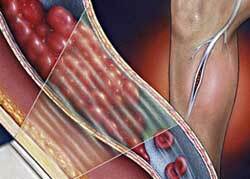 After stihaniya pain and dropping edema patient returns under the supervision of specialists to a mobile lifestyle. Therapeutic exercise is prescribed, first in the reclining position:
After stihaniya pain and dropping edema patient returns under the supervision of specialists to a mobile lifestyle. Therapeutic exercise is prescribed, first in the reclining position:
1. to reproduce the movements of the legs when cycling, completely straightening the legs;
2. bring the bent legs to the chest, straighten them vertically and extend them down;
3. straightened feet on the weight to imitate the movements of scissors.
Compression stockings or elastic bandages from the bottom up are assigned to prevent thrombosis.
Nutrition for thrombosis of the deep veins of the lower extremities provides for the exclusion of food from fried, smoked, spicy products.
Prevention of deep vein thrombosis of the legs
To prevent the development of this dangerous disease, it is required:
- to maintain active mobility throughout life;
- to eat food that does not contribute to the production of cholesterol( fruits, vegetables);
- regularly undergo a medical examination;
- during the day to change shoes with different heel heights to improve venous outflow;
- daily do contrast shower and foot massage;
- to go in for sports.
With a sedentary lifestyle, use any opportunity( sitting at the desk in the office, in the transport, in front of the TV) for the simplest gymnastics. Exercises for the gastrocnemius muscles are spent on exhalation with the retraction of the abdomen:
- fix the heels on the floor, and raise and lower the foot socks,
- fix the toes on the floor, raise the heels,
- by moving the feet from the heel to the toe to move the legs to the right and left,
- to flextoes down and relax.
Part of these exercises can be performed in the standing position.
At home it is useful to sit on the floor with legs outstretched, bring your feet to yourself, and bend your chest to your legs, keeping your back straight. Repeat several times.
After exercising for 5 minutes, keep your feet elevated to improve venous outflow.
In case of varicose veins, in order not to cause blood clots, you should not engage in power sports, limit squats and sharp bends of the trunk. Useful measured walking, swimming and cycling.
Deep vein thrombosis of the lower extremities in the ICD 10
In the ICD 10, deep vein thrombosis is in the section:
Class IX - Diseases of the circulatory system( I00-I99)
I80-I89 - Diseases of veins, lymphatic vessels and lymph nodes not classified inother headings
I80 - Phlebitis and thrombophlebitis
- I80.1 - Phlebitis and thrombophlebitis of the femoral vein
- I80.2 - Phlebitis and thrombophlebitis of other deep vessels of the lower extremities
- I80.3 - Phlebitis and lower limb thrombophlebitis unspecified

